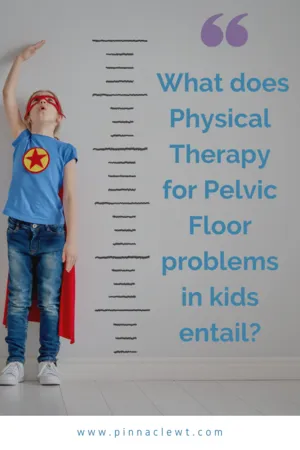By: Heather Jenny, PT — Heather has joined Pinnacle Women’s Therapeutics with over 28 years specializing in pelvic health in adults and children. She is a gift to our community!
Hello There! Surprised to find bladder and bowel problems occur in children? Or maybe you’re not surprised that there can be problems, but that Physical Therapy can help resolve those problems!
That would have been me 30 years ago when I began specializing in pelvic floor physical therapy. At first, I thought only women had these types of problems, then I quickly realized men could have pelvic floor problems too! But kids?
One day, a PT colleague of mine asked me if we could chat in private. She told me that her 9 year old was still having problems with urinary leakage at night – “bed wetting”. She said she felt terrible that she had been unable to help him fix the problem. She reported they had taken him to his pediatrician and a urologist, but he was still having leakage! She wondered if there was anything that I could do to help?
I began researching and found that bladder and bowel problems are common in children! 5-7 Million children in the US experience urinary and/or bowel leakage events after toilet training where they are mostly dry. Of this number, 10% continue to have events after age 6. 10-25% of bedwetting children also have issues with bowel control. (1)
But thankfully, Physical Therapy, in coordination with your physician, can often make all the difference in success!
So you might be wondering, what does Physical Therapy for Pelvic Floor problems in kids entail? Below is an overview of some common things we can do to help your child gain control of their pelvic floor!
Breathe Coordination with the Pelvic Floor
-
The pelvic floor, diaphragm and abdominals are supposed to work together in a coordinated movement pattern. During voiding, the pelvic floor should lengthen and open to allow the bladder or bowels to contract and empty completely.
-
When not voiding, they work together to move the body and prevent leakage of urine and stool.
-
Children can have muscles that don’t work together (pelvic floor muscle dyssynergia), that work opposite of how they are supposed to work (Paradoxical movement) and sometimes, they just don’t know how they are supposed to move!
Education and Coordination
-
Did you know
-
the way your child is supported or not supported on the toilet can affect how they void?
-
Or that what they eat and drink can directly affect both bladder and bowel function?
-
How about that how your child sleeps or if your child snores can affect nighttime urine leakage?
-
-
Childhood leakage often takes a team that includes physicians, nutritional and school professionals. Coordination with the team in critical to success!
-
Communication with your physician(s) is vital to collaborate on medical causes for incontinence.
Exercises
-
The muscles that support the pelvis, legs and trunk all contribute to the pelvic floor working properly. Specific exercises can help all of these muscles work together.
-
The pelvic floor itself may need to work on relaxing and lengthening or on lifting and strengthening. Every child is different which is why it’s so important to have a specialized physical therapist to design an exercise program specific to your child’s situation!
Manual Therapies
-
Sometimes muscles of the pelvis, including the pelvic floor, can be in spasm or have injuries that require stretching or manual therapy to return to normal movement.
If your child is experiencing urinary or stool leakage we are here to help! Reach out via email or phone! You can also schedule a virtual consult to discuss your unique situation. I am here to help you and your child find a path forwards towards normal bowel and bladder function!
(1) Statistics cited from: Austin, P., Bauer S.B., Bower W., et. al. The Standardization of terminology of lower urinary tract function in children and adolescence: update report from standardization committee of the international children’s continence society. Neurourology and Urodynamics 35:471–481 (2016).

Heather Jenny, PT
Do you know what the number one reason applicants give as to why they want to become a Physical Therapist? It’s to help people and I have to confess; it was my number one reason too!
When I had my first child, I suffered a pelvic floor injury. Being a physical therapist, I thought for sure that I would be able to figure out how to fix myself. Boy was I wrong! 28 years ago, there were very few Pelvic Floor PT’s and only one in the entire state I lived in. So, I drove, two hours each way, every week to go see her. As I healed, I realized that I could learn and help other women with pelvic floor problems.
Things have changed a lot since I began my journey to help women with pelvic floor problems! All people have pelvic floors, including men and children, and they can all have problems! Thank goodness, pelvic floor Physical Therapy helps all people!
The pelvic floor is only one part of coordinated core function. It’s vital that the PF works well with the other components including your back, abdominals and your respiratory diaphragm! When they don’t, problems and pain develop!
Because the pelvic floor is integrated with other parts of your body, I became an integrated practitioner! I became certified in an integrated type of therapy called Postural Restoration that assesses people from head to toe and integrates with many different types of providers. I’d love to explain how your breathing, sleep, foot function and jaw function can influence how your pelvic floor works!
I helped develop a multi-disciplinary sexuality and pelvic pain clinic and would love to integrate with your providers to improve your sexual health and pain concerns. I love working with parents and children that have problems with bladder and bowel problems. I realize how problematic and embarrassing both of these spectrums of problems can be! But I am equally excited to tell you that I can help, and you are not alone!
My passion lead me to teach and mentor other PT’s in pelvic floor problems. That passion also lead to becoming part of the first class of board certified PT’s in women’s health physical therapy and in pelvic floor biofeedback.
If you are a person with pelvic floor problems, I am here to help! I hope you reach out or sign up for a virtual consult! I look forward to partnering with you and finding a path forward.



